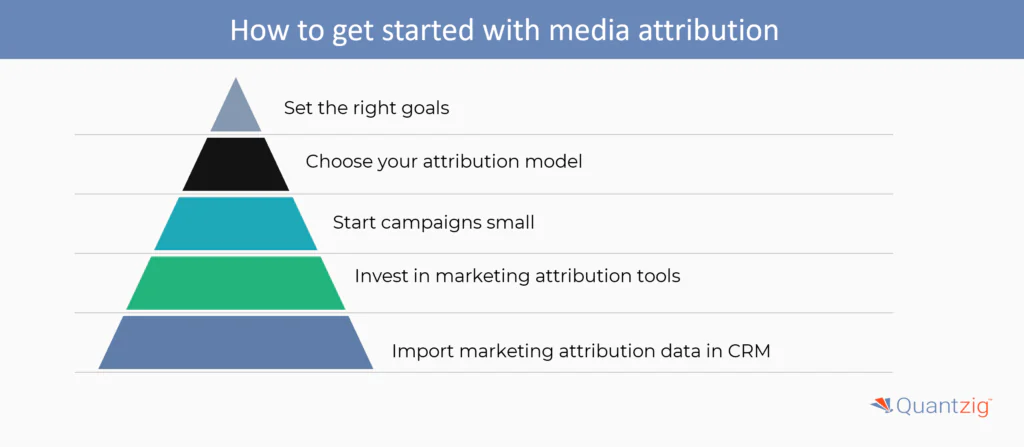Written By: Sudeshna Ghosh
Table of Contents
Key Takeaways
- Digital Media Attribution provides a valuable understanding of the effectiveness of marketing efforts for businesses. By precisely crediting conversions to particular touchpoints, businesses can make data-driven choices to enhance their marketing plans, efficiently allocate resources, and increase ROI.
- With Digital Media Attribution, businesses gain deeper insight into customer actions across different platforms and touchpoints. This understanding enables businesses to customize their marketing communications and campaigns to better fulfill the preferences and needs of their target demographic, eventually improving customer engagement and loyalty.
- By recognizing which media efforts and platforms are generating the most conversions, Digital Media Attribution enables businesses to more efficiently assign their marketing budget.
- Digital Media Attribution enables businesses to more precisely quantify the performance of their marketing campaigns. By monitoring the effect of each touchpoint on the customer journey, businesses can pinpoint areas for enhancement and optimize their campaigns for superior results, eventually increasing conversion rates and revenue.
What is Media Attribution?
The process of monitoring and tracking which media outlets have the greatest influence on your customers’ engagement and, eventually, your sales is known as media attribution. You can maximize your marketing budget by determining which media platforms, promotion strategies, and content are best for your business. According to Quantzig experts, 88% of marketers say that media attribution is essential to comprehending the customer journey and enhancing the efficacy of marketing campaigns.
Introduction to Digital Media Attribution
Marketing attribution refers to the practice of assigning credit for clicks, conversions, and sales to the different marketing channels involved in acquiring a customer. It’s the process of tracking which touchpoints along the customer journey, such as ads, emails, referrals, etc., contribute to winning and converting high-value customers. Without properly attributing conversions to their originating sources, you risk wasting your budget on channels that don’t drive meaningful returns on investment. Attribution helps reveal which channels offer the most value so you can optimize spending accordingly. Let’s explore this concept and how it makes a data-driven digital marketing budget easier than ever to figure out and implement.
Book a demo to experience the meaningful insights we derive from data through our analytical tools and platform capabilities. Schedule a demo today!
Request a Free DemoQuantzig’s Expertise in Digital Media Attribution for a Multinational Telecom Brand
| Category | Details |
|---|---|
| Client Details | A multinational telecom brand headquartered in Europe with annual revenue of $10bn+. |
| Challenges Faced by The Client | The e-commerce team was no proper tool to identify transactional customers who are at risk of retention initiatives and have low propensities. |
| Solutions Offered by Quantzig | Using transactional, channel, behavioral, and demographic data, we created a customer 360 Datamart to understand characteristics affecting brand engagement, used retention modeling and churn prediction to pinpoint at-risk customers and their dissatisfaction drivers, and recommended segment-specific retention and win-back strategies for the client. |
| Impact Delivered | We identified at-risk customer cohorts and their dissatisfaction drivers, enabling systematic retargeting, and supported campaign execution with targeted customer pools, messaging insights, and performance measurements, resulting in a 30% increase in customer retention during the test period. |
Client Details
A multinational telecom brand headquartered in Europe with annual revenue of $10bn+.
Challenges Faced by the Client
Our recent client was a global telecom company headquartered in Europe with $10 billion or more in revenue annually. To identify transactional customers who are at risk of retention initiatives and have low propensities, their e-commerce team was searching for a solution.
Solutions Offered by Quantzig
Using channel, behavioral, transactional, and demographic data, we started by creating a customer 360 Datamart. Every possible characteristic that could affect brand engagement and customer experience was identified. Then, using a combination of churn prediction and retention modeling, we were able to identify customers who posed a greater risk as well as the characteristics that are causing discontent or a lack of brand engagement. For the client to plan their win-back tactics, we also suggested retention plans and win-back strategies at the segment X channel levels.
Impact Delivered
We recognized key customer cohorts at risk and the drivers of their dissatisfaction, enabling systematic retargeting efforts. Additionally, we implemented campaign execution strategies, which included providing messaging insights for campaign planning, identifying the target customer pool for each campaign, and measuring campaign performance to assess uplifts. As a result, the present customer retention rate increased by 30% during the test period.
What is Digital Media Attribution?
Media attribution involves monitoring and analyzing which media outlets and channels have the greatest influence on customer engagement and sales. Identifying the ideal combination of content, promotions, and media platforms that maximize your profits allows you to optimize your marketing budget.
Nowadays, no single media channel alone is likely to be the perfect marketing solution. Even for inexpensive products, consumers research and compare across search engines and social media before making a purchase. Rather, media attribution tracks the customer’s journey of discovering your brand across various channels, content pieces, and even different devices they use.
Also Read: Maximizing Marketing Budgets with Campaign ROI Analysis
Get started with your complimentary trial today and delve into our platform without any obligations. Explore our wide range of customized, consumption driven analytical solutions services built across the analytical maturity levels.
Start your Free Trial TodayWhy is Media Attribution Important?
A crucial element of any effective marketing plan is media attribution. You can maximize your marketing budget and increase return on investment by making data-driven decisions based on precise tracking and analysis of the performance of your different advertising channels. You’re essentially flying blind without proper attribution, unable to identify the campaigns and platforms that are generating the most valuable leads and conversions.
Media attribution gives you an objective, clear picture of your marketing funnel in today’s cutthroat, omnichannel environment. It also helps you pinpoint high-performing touchpoints and cut down on unnecessary spending. Purchasing an attribution solution gives you the power to decide where to spend your hard-earned marketing budget more intelligently and strategically. In a nutshell, media attribution gives you the ability to outperform the competition and maximize the return on your advertising investments.
What are the Digital Media Attribution Models?

There is no single media attribution model that works for every business. Different marketing campaigns might be better evaluated using various models. The appropriate model depends on things like how complex the strategy is, the planned length of the campaign, and how many channels are utilized, among other considerations. There are three main media attribution models, with each representing a distinct level of technical marketing sophistication:
1. Assisted Conversions
This basic method for attributing media can be used through tools such as Google Analytics. With this model, all user interactions before the conversion event are tracked and reported by media type. These include segments like display ads, mobile ads, search ads, and more. This allows you to understand which media channels are important parts of your customer’s journey, even if they aren’t the final interaction that completes the conversion.
2. Rule-Based Attribution
This attribution approach, also called multi-touch attribution, assigns a set percentage of credit to each marketing channel for bringing in and converting customers. But the percentages are based on predefined rules you set. Testing different rule-based models shows which channels do best for initial click, final click, and clicks closer to conversion. However, you may not get as much understanding of unique customer actions across channels.
3. Data-driven attribution
It employs machine learning to assess and determine the media avenues that successfully convert compared to those that do not. Through examining real data detailing actual occurrences, the algorithm can then forecast potential outcomes predicated on modifications to marketing plans. This illuminates not just current media interactions producing conversions, but also those that could theoretically enhance conversions moving forward. One potential impediment is that accounts typically require at least 600 conversions within 30 days to generate sufficient data for the machine learning to operate effectively.
Testing various types of media attribution models will provide insight into your tactics and reveal which are most effective for certain content formats.
Besides, by employing other attribution models such as first-touch attribution, last-touch attribution, linear attribution, time decay attribution, position-based attribution, and last non-direct click, businesses can understand the impact of each touchpoint across social media platforms and other channels. Tools like Google Analytics facilitate marketing attribution by tracking these interactions and measuring conversions accurately. A multi-touch digital attribution model is particularly valuable as it considers multiple interactions, ensuring a comprehensive view of the customer’s path to purchase and helping businesses make informed decisions to enhance their overall marketing effectiveness.
How to Get Started with Digital Media Attribution

Whether you’re new to media attribution or looking to strengthen your understanding of the best practices, we’re here to help.
We asked data-driven marketers to weigh in and share top tips on media attribution. By following the steps below, you’ll find it easier to keep up with your media attribution data and go on to achieve much better results for your business.
- Set the right goals
- Choose your attribution model
- Start campaigns small
- Invest in marketing attribution tools
- Import marketing attribution data in CRM
1. Set the right goals
You need to establish your objectives, just as with most undertakings in life. To put it another way, what do you hope to gain from your media attribution information? Are you looking for insights into your customers’ actions? Maybe you need to validate your expenditures so you can request a larger budget. Or perhaps, like most marketers, you want to figure out which media platforms are having the biggest influence on income. Regardless of the goal, you must be sure you have an explicit understanding of what you want to uncover.
2. Choose your attribution model
After you have established your objectives, you need to decide on an attribution model. Before selecting an attribution model, you must create a clear understanding of your customer’s path to purchase. In essence, a customer journey illustrates how a customer moves through each phase of the funnel before becoming a sale or conversion. The easiest way to build a picture of your customer journey is to use existing information and research from your CRM database and analytics. Here you can identify the touchpoints that convert best for your audience and choose an attribution model that will be most suitable for your customer journey and business. You can also utilize data from tools like Ruler Analytics, search console, and customer personas to gain better insights into your customer journey.
3. Start campaigns small
If you don’t have much experience with media attribution, we recommend beginning with small advertising campaigns. For one thing, this allows you to try it out and make sure you’ve selected the appropriate marketing attribution model for your customer’s path. Additionally, it allows your team to become accustomed to the outcomes of media attribution. As you become more assured, you can gradually increase the diversity of marketing services platforms over time.
4. Invest in marketing attribution tools
The most widely used tool for analyzing attribution data is Google Analytics. As per our survey, 90% of marketers consider Google Analytics as their primary choice for measuring marketing efforts.
While Google Analytics has enabled marketers to attribute clicks and conversions, it has some limitations. Firstly, the attribution window is restricted to 90 days of historical data. This is adequate if you have a short sales cycle with a single-step buying process. However, if your sales cycle exceeds 90 days, you are likely missing crucial data about your customer journeys.
Secondly, Google Analytics provides limited insight into your offline conversions and inbound calls. Initially, Google Analytics was intended to help users understand web and digital metrics rather than traditional marketing. However, despite technological advancements, phone calls and offline interactions are still the most valuable leads for many businesses. 50% of marketers depend on phone calls to generate quality leads. With minimal offline conversion data in Google Analytics, marketers are left guessing the effectiveness of their campaigns. In light of these challenges, marketers are adopting marketing attribution software to track and analyze their data more effectively.
5. Import marketing attribution data in CRM
Marketing attribution platforms allow you to pinpoint who is converting on your website and how they arrived there. However, to successfully connect these leads with revenue, you must transfer your attribution statistics to your CRM. The purpose is to identify which touchpoints are valuable and where to allocate resources to reduce spending. Manually adding marketing attribution and conversion details to your CRM can be complicated and time-intensive. However, with proper CRM tools, it’s effortless.
Accurate tools integrate with practically any platform, enabling you to seamlessly pass marketing source and conversion data to your CRM without the hard work. As leads progress down the funnel, you’ll be able to evaluate the effectiveness of your campaigns, keywords, and landing pages at every phase of your sales pipeline. When a deal closes, you can feed the revenue data back to the marketing touchpoints that sourced the original lead, thus closing the loop between your media channels and revenue.
Also Read: Track Business Progress with Marketing Analytics Dashboard
Experience the advantages firsthand by testing a customized complimentary pilot designed to address your specific requirements. Pilot studies are non-committal in nature.
Request a Free PilotWhy Should You Care About Media Attribution?

Media attribution provides numerous benefits that enable marketers to customize their marketing efforts and boost revenue. Alignment between sales and marketing is a trending topic now more than ever. Sales and marketing alignment is a strategy that unifies your marketing and sales teams to utilize the same data, goals, and objectives.
Whether your business is small, large, or somewhere in between, you cannot afford to overlook sales and marketing alignment. Previously, sales and marketing alignment was a struggle, mainly because both teams worked in silos and focused on different stages of the funnel. However, that has changed with the rise of media attribution. With the help of attribution, both teams have access to the same data and can better understand collaboratively how different interactions influence movement along the customer journey.
Common Mistakes of Digital Media Attribution and How to Avoid Them

For assessing the success of media campaigns and refining marketing strategies, digital media attribution is essential. However, a lot of leadership teams make the same mistakes that distort attribution data and impair decision-making.
1. Using single-touch attribution models excessively
A restricted understanding of customer journeys may result from the exclusive use of first-touch or last-touch attribution. These models frequently overlook additional crucial touchpoints that influence conversions. Use a more comprehensive approach, such as linear attribution, which equally distributes credit across all touchpoints, to prevent this.
2. Ignoring Non-Digital Channels
Analysis may be lacking if digital metrics are the only thing on your mind. To obtain a thorough understanding of your media mix, make sure your attribution models consider traditional channels like traditional print and television advertising.
3. Misattributing Non-Direct Clicks
Direct traffic is excluded from the last non-direct click model, which gives all credit to the click that occurred just before conversion. Although helpful, it may minimize previous interactions. Incorporate this with multi-touch models to achieve a well-rounded viewpoint.
4. Ignoring High-Quality Leads
Not every lead is created equal. Attribution models must distinguish between leads of varying quality to accurately target audiences for pay-per-click advertising and social media outreach initiatives.
5. Absence of Data Integration
It’s critical to integrate data from all sources, including offline and online channels. For precise insights, combine and evaluate attribution data from various sources using sophisticated analytics tools.
Leadership teams may improve the accuracy of their media attribution efforts, which will result in more successful media campaigns that eventually provide higher quality leads and a better return on investment, by addressing these typical errors.
Setting Up the Correct Attribution Model for Social Media
Setting up the right attribution model is crucial if you want to gauge how social media is affecting your marketing efforts. This entails determining which attribution model works best for the channels and marketing objectives that are unique to you. A linear attribution model is frequently a good place to start when it comes to social media because it gives each touchpoint in the customer journey equal weight. It might not be appropriate for every campaign, though. A time-decay attribution model, for instance, may be more successful if you’re running a targeted social media advertising campaign because it places greater emphasis on the most recent interactions.
Alternately, a position-based attribution model can assist you in comprehending how social media fits into the overall customer journey if you’re utilizing it as a component of a larger omnichannel strategy. You can improve the return on investment (ROI) of your marketing strategy and obtain a better understanding of the impact of your social media campaigns by selecting the appropriate attribution model.
How Can Quantzig Help You with a Digital Media Attribution Solution?
Quantzig provides innovative Digital Media Attribution Solutions that empower businesses to unlock the full potential of their digital marketing efforts. Using advanced analytics and machine learning algorithms, our solutions deliver comprehensive insights into the effectiveness of different digital media channels in generating conversions and revenue. By accurately crediting conversions to specific touchpoints along the customer journey, businesses can optimize their marketing strategies, allocate budgets more effectively, and enhance overall return on investment.
Our Digital Media Attribution Solutions take a holistic approach to attribution modeling, covering both online and offline channels to provide a unified view of customer interactions. Through sophisticated data analysis, we enable businesses to identify the most impactful touchpoints, understand the influence of each marketing channel, and tailor their campaigns for maximum impact. With actionable insights from our solutions, businesses can make informed decisions, optimize their marketing mix, and ultimately drive sustainable growth in today’s competitive digital landscape. Partner with Quantzig to revolutionize your digital marketing attribution strategy and stay ahead of the competition.
Conclusion
In the current digital environment, grasping the impact of marketing attempts is vital for enterprises looking to maximize return on investment and spur growth. Digital Media Attribution has a pivotal role in this process by providing insights into how various media campaigns and contact points contribute to generating quality leads. Using approaches like first interaction attribution, final interaction attribution, and linear attribution, businesses can accurately credit conversions to precise marketing channels and accordingly optimize their marketing combination.
To start with Digital Media Attribution, companies should first compile attribution information from diverse sources, including pay-per-click advertising, social media outreach, and traditional print, and television advertising. Leveraging advanced analytics tools and platforms, enterprises can then examine this data to pinpoint the most effective touchpoints and more effectively allocate resources. By adopting Digital Media Attribution, businesses can improve their marketing strategies, enhance decision-making at the leadership level, and ultimately drive better results across their marketing efforts. Embrace Digital Media Attribution today to unlock the full potential of your marketing attempts and stay ahead in the competitive digital landscape.



